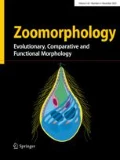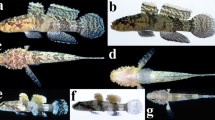Abstract
The morphology of the central nervous system of the tardigrade species Macrobiotus hufelandi was analysed with anti α-tubulin immunostaining in combination with confocal-laser-scanning-microscopy and computer aided three-dimensional reconstruction. The brain anatomy is unexpectedly complex with distinct tracts and highly intermingled nerve fibres. In contrast to older descriptions, we could not detect a suboesophageal ganglion. Furthermore, we found no evidence for a tripartite/three-segmented brain organisation. The median part of the brain is directly connected to the first pair of trunk ganglia via circumoesophageal connectives. Surprisingly, the four paired ventral ganglia do not show segmental commissures typical for the ladder-like nervous system of arthropods. Our findings constrain the phylogenetic position of Tardigrada. The much simpler organisation of the central nervous system of Tardigrada compared to that of Onychophora and Euarthropoda and some similarities to the nervous system of Cycloneuralia support a phylogenetic position of Tardigrada outside an Onychophora/Euarthropoda clade. This means that Tardigrada might be either the sister group to all other Arthropoda or they are more closely related to Cycloneuralia.






Similar content being viewed by others
References
Aguinaldo AMA, Turbeville JM, Linford LS, Rivera MC, Garey JR, Raff RA, Lake JA (1997) Evidence for a clade of nematodes, arthropods and other moulting animals. Nature 387:489–493
Ax P (1999) Das System der Metazoa II. Ein Lehrbuch der phylogenetischen Systematik. Fischer Verlag, Stuttgart
Ax P (2001) Das System der Metazoa III. Ein Lehrbuch der phylogenetischen Systematik. Fischer Verlag, Stuttgart
Basse A (1905) Beiträge zur Kenntnis des Baues der Tardigraden. Z wiss Zool 80:259–281
Bergström J, Hou X-G (2001) Cambrian Onychophora or xenusians. Zool Anz 240:237–245
Brusca R, Brusca GJ (2002) Invertebrates. Sinauer Associates, Sunderland
Budd GE (2001) Tardigrades as “stem- group arthropods”: the evidence from the Cambrian fauna. Zool Anz 240:265–279
Bullock TH, Horridge GA (1965) Structure and function in the nervous system of invertebrates. WH Freeman, San Francisco
Dewel RA, Dewel WC (1996) The brain of Echiniscus viridissimus Peterfi, 1956 (Heterotardigrada): a key to understanding the phylogenetic position of tardigrades and the evolution of the arthropod head. Zool J Linn Soc 116:35–49
Dewel RA, Dewel WC (1997) The place of tardigrades in arthropod evolution. In: Fortey RA, Thomas RH (eds) Arthropod Relationships. Chapman and Hall, London, pp 109–123
Dewel RA, Budd GE, Castano DF, Dewel WC (1999) The organisation of the suboesophageal nervous system in tardigrades: insights into the evolution of the arthropod hypostome and tritocerebrum. Zool Anz 238:191–203
Dove H, Stollewerk A (2003) Comparative analysis of neurogenesis in the myriapod Glomeris marginata (Diplopoda) suggests more similarities to chelicerates than to insects. Development 130:2161–2171
Doyère L (1840) Mémoire sur les Tardigrades. Ann Sci Nat 14:269–361
Edgecombe GD, Wilson GDF, Colgan DJ, Gray MR, Cassis G (2000) Arthropod cladistics: combined analysis of histone H3 and U2 snRNA sequences and morphology. Cladistics 16:155–203
Eriksson BJ, Tait NN, Budd GE (2003) Head development in the Onychophoran Euperipatoides kanagrensis with particular reference to the central nervous system. J Morph 255:1–23
Fanenbruck M, Harzsch S, Wägele J-W (2004) The brain of the Remipedia (Crustacea) and an alternative hypothesis on their phylogenetic relationships. Proc Nat Acad Sci USA 101:3868–3873
Gabriel WN, Goldstein B (2007) Segmental expression of Pax3/7 and Engrailed homologs. Dev Genes Evol 217:421–433
Garey JR (2001) Ecdysozoa: The relationship between Cycloneuralia and Panarthropoda. Zool Anz 240:321–330
Garey JM, Krotec M, Nelson DR, Brooks J (1996) Molecular analysis supports a tardigrade-arthropod association. Invert Biol 115:79–88
Garey J, Nelson DR, Mackey L, Li J (1999) Tardigrade phylogeny: Congruency of morphological and molecular evidence. Zool Anz 238:205–210
Giribet G, Carranza S, Baguñà J, Riutort M, Ribera C (1996) First molecular evidence for the existence of a Tardigrada + Arthropoda clade. Mol Biol Evol 13:76–84
Giribet G (2003) Molecules, development and fossils in the study of metazoan evolution; Articulata versus Ecdysozoa revisited. Zoology 106:303–326
Greeff R (1865) Ueber das Nervensystem der Bärthierchen, Arctiscoida C.A.S. Schultze (Tardigraden Doyère) mit besonderer Berücksichtigung der Muskelnerven und deren Endigungen. Arch Mikrosk Anat 1:101–122
Greven H (1980) Die Bärtierchen. Ziemsen Verlag, Wittenberg
Greven H, Kuhlmann D (1972) Die Struktur des Nervengewebes von Macrobiotus hufelandi C.A.S. Schultze (Tardigrada). Z Zellforsch 135:131–146
Hanström B (1928) Vergleichende Anatomie des Nervensystems der wirbellosen Tiere unter Berücksichtigung seiner Funktion. Springer, Berlin
Harzsch S (2004a) The tritocerebrum of Euarthropoda: a “non-drosophilocentric” perspective. Evol Dev 6:303–309
Harzsch S (2004b) Phylogenetic comparisons of serotonin-immunoreactive neurons in representatives of the Chilopoda, Diplopoda, and Chelicerata: implications for arthropod relationships. J Morph 259:198–213
Harzsch S (2006) Neurophylogeny: architecture of the nervous system and a fresh view on arthropod phylogeny. Integr Comp Biol 46:162–194
Hejnol A, Schnabel R (2005) The Eutardigrade Thulinia stephaniae has an indeterminate development and the potential to regulate early blastomere ablations. Development 132:1349–1361
Holmgren N, (1916) Zur vergleichenden Anatomie des Gehirns von Polychaeten, Onychophoren, Xiphosuren, Arachniden, Crustaceen, Myriapoden und Insekten. Kunglig Svenska Vetensk Akad Handl Stockholm 56:1–303
Jørgensen A, Kristensen RM (2004) Molecular phylogeny of Tardigrada- investigation of the monophyly of Heterotardigrada. Mol Phyl Evol 32:666–670
Jenner RA, Scholtz G (2005) Playing another round of metazoan phylogenetics: Historical epistemology, sensitivity analysis, and the position of Arthropoda within the Metazoa on the basis of morphology. In: Koenemann S, Jenner RA (eds) Crustacea and Arthropod Relationships. CRC Press, Boca Raton, pp 355–385
Kinchin IM (1994) The Biology of Tardigrades. Portland Press, London
Kristensen RM (1982) The first record of cyclomorphosis in Tardigrada based on a new genus and species from Arctic meiobenthos. Z Zool Syst Evolutionsforsch 20:249–270
Kristensen RM (2003) Comparative morphology: do the ultrastructural investigations of Loricifera and Tardigrada support the clade Ecdysozoa? In: Legakis A, Sfenthourakis S, Polymeni R, Thessalou-Legaki M (eds) The New Panorama of Animal Evolution: Proceedings XVIII International Congress of Zoology. Pensoft, Sofia, pp 467–477
Kristensen RM, Higgins RP (1984a) A new family of Arthrotardigrada (Tardigrada: Heterotardigrada) from the Atlantic coast of Florida, USA. Trans Am Microsc Soc 103:295–311
Kristensen RM, Higgins RP (1984b) Revision of Styraconyx (Tardigrada: Halechiniscidae) with descriptions of two new species from Disko Bay, West Greenland. Smithson Contrib Zool 391:1–40
Loesel R (2005) Editorial - The arthropod brain: retracing six hundred million years of evolution. Arthropod Struct Dev 34:207–209
Maas A, Waloszek D (2001) Cambrian derivatives of the early arthropod stem lineage, pentastomids, tardigrades and lobopodians—an ‘Orsten’ perspective. Zool Anz 240:451–459
Marcus E (1929) Tardigrada. In: Bronn HG (ed) Klassen und Ordnungen des Tierreichs. Akademische Verlagsgesellschaft, Leipzig, pp 1–609
Mallatt J, Giribet G (2006) Further use of nearly complete 28S and 18S rRNA genes to classify Ecdysozoa:37 more arthropods and a kinorhynch. Mol Phyl Evol 40:772–794
Mayer G, Harzsch S (2007) Immunolocalization of serotonin in Onychophora argues against segmental ganglia being an ancestral feature of arthropods. BMC Evol Biol 7:118
Moon SY, Kim W (1996) Phylogenetic position of the Tardigrada based on the 18S ribosomal RNA gene sequences. Zool J Linn Soc 116:61–69
Müller MCM (2006) Polychaete nervous systems: Ground patterns and variations-cLS microscopy and the importance of novel characteristics in phylogenetic analysis. Integr Comp Biol 46:125–133
Nebelsick M (1993) Introvert, mouth cone, and nervous system of Echinoderes capitatus (Kinorhyncha, Cyclorhagida) and implications for the phylogenetic relationships of Kinorhyncha. Zoomorphology 113:211–232
Neuhaus B (1994): Ultrastructure of alimentary canal and body cavity, ground pattern, and phylogenetic relationships of the Kinorhyncha. Micro Mar 9:61–156
Nichols PB, Nelson DR, Garey JR (2006) A family level of analysis of tardigrade phylogeny. Hydrobiologia 558:53–60
Nielsen C (2001) Animal Evolution: Interrelationships of the Living Phyla. Oxford University Press, Oxford
Park J-K, Rho HS, Kristensen RM, Kim W, Giribet G (2006) First molecular data on the phylum Loricifera – An investigation into the phylogeny of Ecdysozoa with emphasis on the positions of Loricifera and Priapulida. Zool Sci 23:943–954
Plate L (1889) Beiträge zur Naturgeschichte der Tardigraden. Zool Jahrb Anat 3:487–550
Ramazzotti G, Maucci W (1983) Il Philum Tardigrada. Mem Ist Ital Idrobiol 41:1–1012
Richters F, Krumbach TH (1926) Tardigrada. In: Kükenthal W, Krumbach TH (eds) Handbuch der Zoologie 3. Berlin und Leipzig, pp 1–68
Ruhberg H (2004) Onychophora, Stummelfüßer. In: Westheide W, Rieger R (eds) Spezielle Zoologie. Spektrum Akademischer Verlag, Heidelberg, pp 420–428
Sandemann DC, Scholtz G, Sandemann RE (1993) Brain evolution in decapod Crustacea. J Exp Zool 265:112–133
Schmidt-Rhaesa A (2001) Tardigrades—are they really miniaturized dwarfs? Zool Anz 240:549–555
Schmidt-Rhaesa A, Kulessa J (2007) Muscular architecture of Milnesium tardigradum (Tardigrada) and other eutardigrades. Zoomorphology (in press)
Schmidt-Rhaesa A, Ehlers U, Bartolomaeus T, Lemburg C, Garey JR (1998) The phylogenetic position of the Arthropoda. J Morph 238:263–285
Scholtz G (2002) The Articulata hypothesis- or what is a segment? Org Divers Evol 2:197–215
Scholtz G, Edgecombe GD (2005) Heads, Hox and the phylogenetic position of trilobites. In: Koenemann S, Jenner R (eds) Crustacea and Arthropod Relationships. CRC Press, Boca Raton, pp 139–165
Scholtz G, Edgecombe GD (2006) The evolution of arthropod heads: reconciling morphological, developmental and palaeontological evidence. Dev Genes Evol 216:395–415
Schürmann FW (1995) Common and special features of the nervous system of Onychophora: a comparison with Arthropoda, Annelida, and some other invertebrates. In: Breidbach O, Kutsch W (eds) The Nervous Systems of Invertebrates: An Evolutionary and Comparative Approach. Birkhäuser, Basel, pp 139–158
Storch V (1991) Priapulida. In: Harrison FW (ed) Microscopic Anatomy of Invertebrates, vol 4, Wiley-Liss, New York, pp 333–350
Strausfeld NJ, Strausfeld CM, Stowe S, Rowell D, Loesel R (2006) The organization and evolutionary implications of neuropils and their neurons in the brain of the onychophoran Euperipatoides rowelli. Arthropod Struct Dev 35:169–196
Thulin G (1928) Über die Phylogenie und das System der Tardigraden. Hereditas 11:207–266
Walz B (1978) Electron microscopic investigation of cephalic sense organs of the Tardigrade Macrobiotus hufelandi C.A.S. Schultze. Zoomorphology 89:1–19
Wiederhöft H, Greven H (1996) The cerebral ganglia of Milnesium tardigradum Doyère (Apochela, Tardigrada): three dimensional reconstruction and notes on their ultrastructure. Zool J Linn Soc 116:71–84
White JG, Southgate E, Thomson JN, Brenner S (1986) The structure of the nervous system of the nematode Caenorhabditis elegans. Phil Trans R Soc B 314:1–340
Whitington PM (2007) The evolution of arthropod nervous systems: insights from neural development in the Onychophora and Myriapoda. In: Kaas JH (eds) Evolution of Nervous Systems, vol 1, theories, development, invertebrates. Elsevier, Amsterdam, pp 317–336
Wright KA (1991) Nematoda. In: Harrison FW (ed) Microscopic Anatomy of Invertebrates, vol 4. Wiley-Liss, New York, pp 111–195
Acknowledgments
We thank Greg Edgecombe for critical comments and the members of the group “Vergleichende Zoologie” at the Humboldt-Universität zu Berlin for many discussions and practical advices.
Author information
Authors and Affiliations
Corresponding author
Electronic supplementary material
The movies are interactive VR-QuickTime-movies and require a current version of QuickTime and JavaScript. By going with the mouse cursor into the movie frame and pressing the left mouse button you can move the 3-D-reconstruction in any position.
Movie 1
: Ventral view of the entire body of Macrobiotus hufelandi (Hoechst, α-tubulin). Anterior is up. Visible are the arrangements of cell nuclei and fibre bundles in the head and the connection of the four ventral ganglia by the paired connectives (MOV 12.2 Mb)
Movie 2
: Structure of the brain of Macrobiotus hufelandi (α-tubulin). In the starting position anterior is up, dorsal view. Visible are the dorsal commissure, preoral commissure, nerves n4 and n13, and the dorsal expansion of the dorsal clusters (MOV 14.5 Mb)
Movie 3
: Nervous system in the head and the first ventral ganglion of Macrobiotus hufelandi (α-tubulin). Anterior is up, ventral view. The connectives of the chain of ventral ganglia run anteriorly representing the inner connectives which merge into the inner lobes of the brain. The outer connectives merge into the outer lobes (MOV 13.2 Mb)
Rights and permissions
About this article
Cite this article
Zantke, J., Wolff, C. & Scholtz, G. Three-dimensional reconstruction of the central nervous system of Macrobiotus hufelandi (Eutardigrada, Parachela): implications for the phylogenetic position of Tardigrada. Zoomorphology 127, 21–36 (2008). https://doi.org/10.1007/s00435-007-0045-1
Received:
Revised:
Accepted:
Published:
Issue Date:
DOI: https://doi.org/10.1007/s00435-007-0045-1




